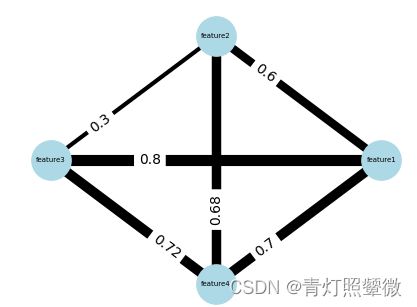【python】可视化-绘制带有边权重的无向图
文章目录
-
- 需求
- 示例数据
- 代码实现
需求
输入数据表(矩阵),绘制无向图。
示例数据
**示例数据1:**3个特征之间的关系数据 (data1.txt)
| features | feature1 | feature2 | feature3 |
|---|---|---|---|
| feature1 | 1 | 0.6 | 0.8 |
| feature2 | 0.6 | 1 | 0.3 |
| feature3 | 0.8 | 0.3 | 1 |
**示例数据2:**4个特征之间的关系数据 (data2.txt)
| features | feature1 | feature2 | feature3 | feature4 |
|---|---|---|---|---|
| feature1 | 1 | 0.6 | 0.8 | 0.7 |
| feature2 | 0.6 | 1 | 0.3 | 0.68 |
| feature3 | 0.8 | 0.3 | 1 | 0.72 |
| feature4 | 0.7 | 0.68 | 0.72 | 1 |
代码实现
import pandas as pd
import numpy as np
import networkx as nx
import matplotlib.pyplot as plt
from collections import OrderedDict
import math
def calculate_circle_points(n, r=1, center=(0, 0)):
"""
将圆按弧线等分后, 分割点的坐标
=========================
Parameters
----------
n: int
等分的份数
r: float, int, optional[1]
圆的半径, 默认[1]
center: tuple, optional [(0, 0)]
圆的中心, 默认(0, 0)
Returns
-------
points: list
划分后的点坐标list
"""
points = []
circumference = 2 * math.pi * r # 圆的周长
for i in range(n):
theta = (i / n) * circumference # 当前等分点所对应的弧长
x = center[0] + math.cos(theta) # x 坐标
y = center[1] + math.sin(theta) # y 坐标
points.append((x, y))
return points
def list2dict_tuple(lst):
"""
根据list的元素个数, 定义字典的布局
===============================
布局为一个圆形
Paramters
---------
lst: list
输入list
Retures
-------
odict:
根据list元素个数 返回每个元素位置字典
"""
n = len(lst) # 节点数
# 圈上的点坐标
circle_points = calculate_circle_points(n)
# 坐标和点构成字典
odict = OrderedDict()
for node_i, point in zip(lst, circle_points):
odict[node_i] = point
return odict
def draw_nx_graph(matrix, outfig=None, fixed_node=False):
"""
输入矩阵数据,绘制无向图
Parameters
----------
matrix: DataFrame
矩阵数据
比如, 多个特征间的相关性矩阵
outfig: str, optional [None]
默认None, 不输出绘图, 否则设置绘图路径
fixed_node: bool, optional [False]
固定节点位置
- 特征较少时, 可设置为True
- 特征较多时, 建议设置为False
因为设置固定节点位置, 可能会影响节点之间的边连线或出现边的标签覆盖问题
Returns
-------
None
"""
# 画布大小
plt.figure(figsize=(4, 3))
# 创建空的无向图
G = nx.Graph()
# 添加节点
for node in matrix.columns:
G.add_node(node)
# 添加边
for row, col in zip(
*matrix.where(pd.np.triu(pd.np.ones(matrix.shape), k=1).astype(bool)).stack().reset_index().drop(columns=0).values.T
):
value = matrix.loc[row, col]
G.add_edge(row, col, weight=value)
# 绘制无向图
edges = G.edges()
weights = [G[u][v]['weight'] for u, v in edges]
if fixed_node:
# 固定节点位置 (特征较少时)
nodelst = G.nodes() # 获取节点名称list
posdict = list2dict_tuple(nodelst) # 根据list元素个数布局节点位置
# posdict = {'feature1': (0, 0), 'feature2': (0, 1), 'feature3': (1, 0)}
else: # 特征较多时
posdict = None
# print(posdict)
nx.draw(
G, pos=posdict,
with_labels=True,
font_size=5, # 节点标签字体
node_color="lightblue", # 节点颜色
node_size=800,
width=np.array(weights)*10,
)
if fixed_node:
labels = nx.get_edge_attributes(G, 'weight')
nx.draw_networkx_edge_labels(
G, posdict, edge_labels=labels,
label_pos=0.3,
)
# nx.draw_networkx_edge_labels(G, pos=nx.spring_layout(G), edge_labels=labels)
else:
print(
"NOTE: not fixed note pos, will not add labels of edges. "
"And network graph will be changed, every time this script is executed."
)
# 输出绘图
if outfig:
plt.savefig(outfig)
plt.show(block=False)
plt.pause(1)
plt.close()
def main(datafile, outfig=None, fixed_node=False):
# 读取数据
matrix = pd.read_csv(datafile, sep='\t', index_col=0)
# 调用函数绘制无向图
draw_nx_graph(matrix, outfig, fixed_node)
使用示例1:
datafile = './data1.txt'
# outfig = './data1.nx_grpaph.pdf'
main(datafile, fixed_node=True, outfig=None)
示例2:
datafile = './data2.txt'
# outfig = './data2.nx_grpaph.pdf'
main(datafile, fixed_node=True, outfig=None)

